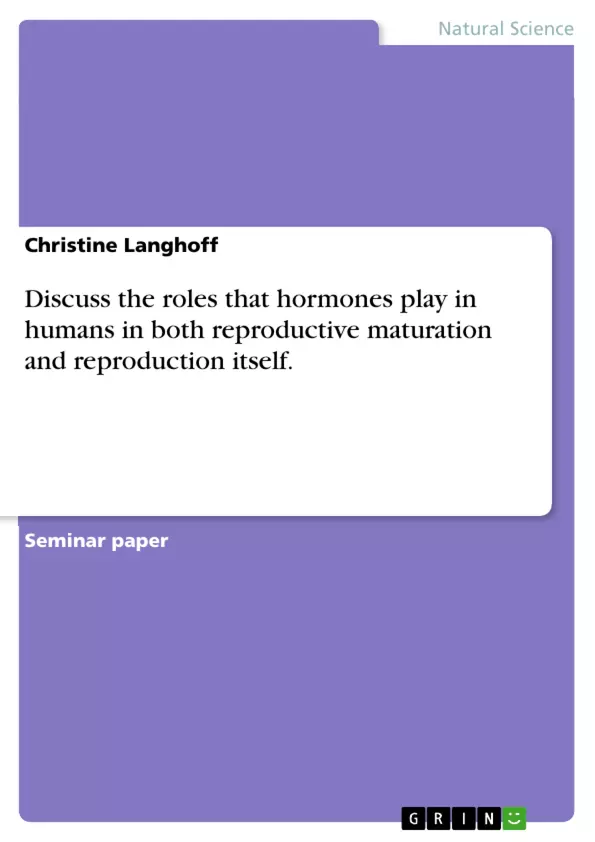Discuss the roles that hormones play in humans
in both reproductive maturation and reproduction itself.
by
Christine Langhoff
Hormones are molecules which are transported in the blood and act as chemical messengers. They are produced by various cells and glands that make up the endocrine system. The blood transports the hormones throughout the body, but they only produce responses in certain target cells or organs. In humans hormones play an important role in both reproductive maturation and reproduction itself.
Sex differentiation
When looking at sex differentiation we first have to look at sex determination. Sex is genetically determined by the Y chromosome. This is because if a Y chromosome is present an individual will develop the male gonads (testes) due to a gene called SRY (′sex-determining region Y gene′) which is located on the Y chromosome. SRY is a controller gene which regulates the expression of all the other structural genes that are required to make the testis and which lie on other autosomal chromosomes as well as on the X chromosome. The number of X chromosomes or autosomes present does not affect the primary determination of gonadal sex.
In both sexes the gonads are derived embryologically from a common precursor made up of two distinct tissues: somatic mesenchymal tissues, which form the matrix of the gonad, and the primordial germ cells (PGCs), which migrate into and colonise this matrix to form the gametes. Both tissues are located in an area called the urogenital ridge. Until the sixth week of uterine life, there is no differentiation of this site, but the primitive medullary cords and the sex cords are formed. At this time (end of sixth week / beginning of seventh week), and in male embryos only, the definitive testis cords are formed. These cords incorporate most of the PGCs within their columns and secrete an outer basement membrane. They are known as the seminiferous cords, and will give rise to the seminiferous tubules of the adult. Of the two cell populations within the cords, the PGCs, now known as prospermatogonia, will give rise to spermatozoa, and the mesodermal cord cells give rise to Sertoli cells. Between the cords, the loose mesenchyme vascularises and develops as stromal tissue, within which cells condense in clusters to form specific endocrine units, the interstitial glands of Leydig.
[...]
Inhaltsverzeichnis (Table of Contents)
- Sex differentiation
- Puberty
- Spermatogenesis
- Oestrous/Menstrual cycle and ovulation
Zielsetzung und Themenschwerpunkte (Objectives and Key Themes)
This text aims to discuss the roles of hormones in human reproductive maturation and reproduction. It explores the hormonal mechanisms underlying sex differentiation, puberty, spermatogenesis, and the menstrual cycle.
- Hormonal regulation of sex differentiation
- Hormonal control of puberty
- The role of hormones in spermatogenesis
- Hormonal regulation of the menstrual cycle
- The interplay of various hormones in reproductive processes
Zusammenfassung der Kapitel (Chapter Summaries)
Sex differentiation: This section details the genetic and hormonal mechanisms determining sex, focusing on the roles of the SRY gene, Leydig cells (producing androgens), and Sertoli cells (producing Müllerian inhibiting substance). It explains how these hormones influence the development of both internal and external genitalia in males and females.
Puberty: This section describes the maturation of reproductive organs and the development of secondary sexual characteristics during puberty. It explains the roles of gonadotropin-releasing hormone (GnRH), pituitary gonadotropins, estrogens, and androgens in initiating and regulating pubertal changes in both sexes.
Spermatogenesis: This section outlines the process of sperm production, including mitotic proliferation, meiotic division, and cytodifferentiation. It highlights the roles of follicle-stimulating hormone (FSH), luteinizing hormone (LH), and testosterone in regulating spermatogenesis, emphasizing the synergistic actions of FSH and testosterone on Sertoli cells.
Schlüsselwörter (Keywords)
Hormones, sex differentiation, SRY gene, androgens, Müllerian inhibiting substance, puberty, GnRH, gonadotropins, estrogens, testosterone, spermatogenesis, FSH, LH, menstrual cycle, ovulation.
- Citar trabajo
- BA (Oxon), Dip Psych (Open) Christine Langhoff (Autor), 2001, Discuss the roles that hormones play in humans in both reproductive maturation and reproduction itself., Múnich, GRIN Verlag, https://www.grin.com/document/7624



